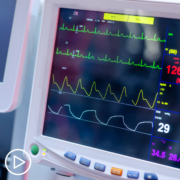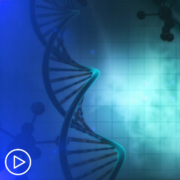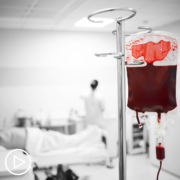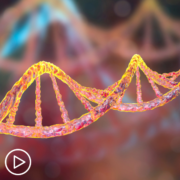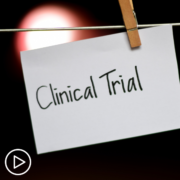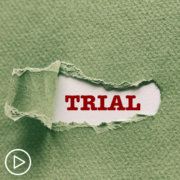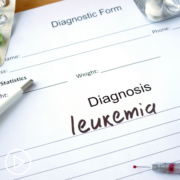What Should Patients Know About Myeloma Testing? from Patient Empowerment Network on Vimeo.
Testing following a myeloma diagnosis, or relapse, can impact care and treatment decisions. Drs. Betsy O’Donnell and Omar Nadeem provide an overview of essential myeloma testing, how the test results impact staging, and discuss recent advances in testing that have changed myeloma care.
Dr. Omar Nadeem is the Clinical Director of the Myeloma Immune Effector Cell Therapy Program and Associate Director of the Multiple Myeloma Clinical Research Program at the Dana-Farber Cancer Institute. Learn more about Dr. Nadeem.
Dr. Betsy O’Donnell is Assistant Professor of Medicine at the Dana-Farber Cancer Institute specializing in Plasma Cell Disorders.
See More From INSIST! Myeloma
Related Programs:
Transcript:
Katherine Banwell:
Dr. O’Donnell, let’s move on to testing. What tests are necessary to help understand a patient’s specific disease?
Dr. Betsy O’Donnell:
Absolutely. So, testing really does depend a little bit on the stage at which your disease is found. In general, we use a very specific blood test that lets us know that there is clonal protein present. Remember, plasma cells are a type of white blood cell, and they make something called antibodies. We use a test called a serum protein electrophoresis, which is a blood test – an SPEP, we call it – that can tell us the difference between normal, healthy antibody and clone that are made from the plasma cells that we see in MGUS, smoldering, and multiple myeloma.
So, that’s a very important test, and sometimes your primary care doctor may notice that your total protein is elevated and send that test.
Or there may be other things that tip them off. Perhaps the kidneys are not where they used to be. And so that test is sent, and that’s the first tip-off that someone might have a plasma cell disorder.
Once we identify that there’s a plasma cell disorder, then that can set in place a workup, depending on the amount of clonal, monoclonal, M-protein that we see. So, sometimes that involves bone imaging. Historically that was a skeletal survey where we took lots of X-rays of your body. Now we have other tests we use. PET scans, CT scans, whole body MRIs. Sometimes it depends where you’re getting your treatment, and also it depends a little bit on your doctor’s degree of suspicion.
Bone marrow biopsies are a procedure that we sometimes do. We use a thin, hollow needle to take out just a little piece of bone, about the size of an inchworm, and take some fluid with it. There’s actually fluid inside the bone marrow.
And that can tell us, just as Dr. Ghobrial was defining the spectrum of plasma cell disorders, based on the percent of plasma cells, that can tell us where somebody belongs, which group they might belong in. So, we can use all of these tests to help give us a good sense of how much disease someone has and where in the spectrum or continuum a person is – MGUS, smoldering, or multiple myeloma.
Katherine Banwell:
Okay, great. Thank you. I’m assuming these tests can help with understanding the stage of a patient’s myeloma. So, Dr. Nadeem, how is myeloma staged?
Dr. Omar Nadeem:
Yes. So, myeloma is staged very differently than traditional cancers. Because this is a blood disease, we don’t really think about it like we may in other solid tumor cancers, where if it’s spread to multiple locations it’s IV, etcetera. That doesn’t apply to multiple myeloma. It’s actually staged out of three stages, and uses your blood work for the most part, some blood tests, to help identify which stage you are. Historically, that has correlated with how you may do.
However, now we are learning that it’s far more to this story than just the blood work. So, we’re now using our bone marrow test results, particularly a test called a FISH test, which looks at the mutations that are present in examinable plasma cells, and if you have presence of some of these high-risk markers, that can actually either upstage you or downstage you if you don’t.
So, we’re now I think becoming a little bit smarter how we think about this disease. It’s not just based on some blood test. We’re actually looking at the biology of some of these cells and the amount in the bone marrow. A lot of times patients ask, “Well, if I have 50 percent, 60 percent, or 80 percent involvement of the bone marrow, that actually does not have anything to do with staging, right?” So, I think it’s important to know that it’s actually a very unique staging system in multiple myeloma.
Katherine Banwell:
Okay. Dr. O’Donnell, the landscape of myeloma has changed significantly in recent years. How have advances in testing changed care from myeloma patients?
Dr. Betsy O’Donnell:
So, I mean, the landscape has changed incredibly just in terms of the treatments we have, and I think that Dr. Nadeem was talking about something really important.
In that when we look at FISH, which allows us to know the biology a little bit more, sometimes it helps us to decide kind of the risk that a patient is. We aren’t really at the point now where we do truly tailored therapies, like you see in some cancers, where we can detect specific mutations and pick drugs that align with that, but there are some that we do use. An example would be a drug called venetoclax (Venclexta), which works very well in patients who have a specific translocation, 11;14.
So, there is some degree in which we use that FISH and those cytogenetics to help define our treatments, but also really we’re just fortunate that we have new and evolving therapies. We’ve changed how we treat myeloma in the up-front setting, and then at the back end we have an exploding field of immunotherapies, CAR-T cells, bispecific antibody that we’re now using that really have tremendously benefited our patients.
Katherine Banwell:
Dr. O’Donnell, should all patients undergo in-depth testing, like cytogenetics?
Dr. Betsy O’Donnell:
Yes, so if you’re doing a bone marrow biopsy, absolutely. The question in terms of who needs bone marrow biopsies, if someone has a low risk MGUS, those patients don’t necessarily require a bone marrow biopsy. It’s an invasive procedure, it’s an uncomfortable procedure. But if we’re doing a workup for multiple myeloma or smoldering myeloma that includes a bone marrow biopsy, then absolutely.
Katherine Banwell:
Okay. Dr. Nadeem, what are you looking for with cytogenetics, and how might test results affect prognosis and treatment?
Dr. Omar Nadeem:
Yes, so as mentioned earlier, there are some mutations that are considered high risk, I will say with the caveat that we don’t fully understand every single mutation yet or have identified every single mutation yet that may be high risk or low risk.
But there are roughly five that we have identified that if a patient has one or two or several of those abnormalities, then their disease may behave a little bit more aggressively or may not respond as well to treatment.
However, I think myeloma is just very complicated, so we look at a lot of these results in the beginning, both whether they may be good or bad. But I think, ultimately, we have to see how patients do, and that by far is the most important prognostic factor, in my opinion. So, if we look at some of these tools, including staging, some of the bone marrow results and cytogenetics, and try to give some prediction in terms of what we may see from this person’s disease, but ultimately the treatments that are so effective now really dictate the course for the majority of the patients.
Katherine Banwell:
Are there specific tests that patients should ask for that could impact their care decisions?
Dr. Omar Nadeem:
Yes, I think it depends on where they are in their disease state. So, if we’re looking at whether a patient has a precursor or plasma cell disorder or multiple myeloma, then they need all the testing to help us figure that out.
So, that includes a bone marrow biopsy, the FISH testing as we just talked about. Advanced imaging like a PET scan or an MRI is now critical to identify patients that may have multiple myeloma versus those that have a precursor condition. So, we used to count on X-rays, as Dr. O’Donnell mentioned, but now really we do prefer one of those advanced imaging techniques for patients to undergo so that we can know.
So, I think if they have basically those tests completed, that gives us most of the information that we need.












